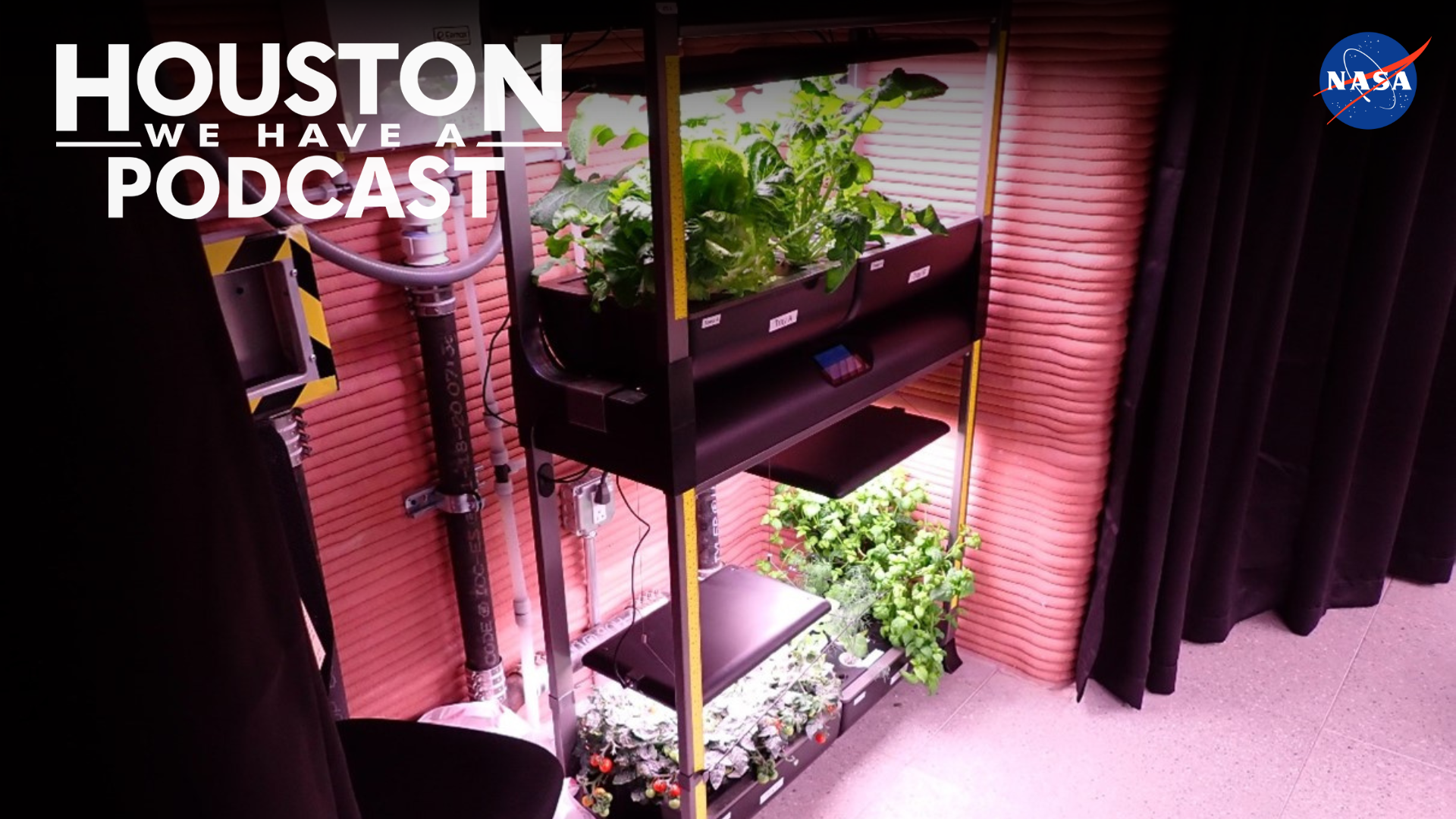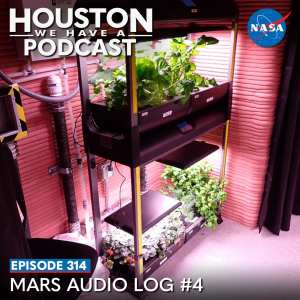
From Earth orbit to the Moon and Mars, explore the world of human spaceflight with NASA each week on the official podcast of the Johnson Space Center in Houston, Texas. Listen to in-depth conversations with the astronauts, scientists and engineers who make it possible.
On episode 314, the CHAPEA crew gives an update amid their one-year stay in a simulated Mars habit, and Gioia Massa discusses the crop production on Mars. This is the fourth audio log of a monthly series. Recordings were sent from the CHAPEA crew throughout October 2023. The conversation with Dr. Massa was recorded October 31, 2023.

Transcript
Host (Gary Jordan): Houston, we have a podcast! Welcome to the official podcast of the NASA Johnson Space Center, Episode 314 “Mars Audio Log #4.” I’m Gary Jordan, and I will be your host today. On this podcast we bring in the experts: scientists, engineers, and astronauts, all to let you know what’s going on in the world of human spaceflight, and more. We’re back with another log from the CHAPEA crew! CHAPEA , or Crew Health and Performance Exploration Analog, is a year-long analog mission in a habitat right here on Earth that is simulating very closely what it would be like to live on Mars. We’re lucky enough to have monthly check-ins with the crew: Commander, Kelly Haston; Flight Engineer, Ross Brockwell; Medical Officer, Nathan Jones; and Science Officer, Anca Selariu.
To meet the needs of fitting in with this analog and simulating significant communications delays between Earth and Mars that prohibit us from having a live conversation, the crew is recording an audio log based on questions that we draft for them. On this episode, we’ll play the recording of their fourth month in the habitat, which is here at NASA’s Johnson Space Center, and was recorded in October 2023.
We’ll also be bringing on a special guest to learn even more about CHAPEA. This month is on a subject which, if you’ve been following this series, is something the crew has been excited about since they started – crops! This month, we speak with NASA’s life sciences project scientist Gioia Massa, one of NASA’s foremost experts on space crop production, to discuss the crop aspect of the CHAPEA mission. And it goes beyond just “can crops grow on Mars.” Growing crops may take a lot of resources, so scientists are looking to better understand crop production’s contribution to crew health and performance. And this could help us better understand the resources and necessity of crop production for a human mission to Mars. While she’s normally stationed at NASA’s Kennedy Space Center in Florida, we caught Gioia while she was here in Houston to check in on the CHAPEA crops. So with that, let’s learn from the CHAPEA crew on how they’re doing, and Gioia Massa on the CHAPEA crop production. Let’s get into it!
[Music]
Host: First is CHAPEA Mission Commander, Kelly Haston.
Kelly Haston: Hi, I’m Kelly Haston. I’m commander on CHAPEA Mission 1, a one-year Mars analog mission out of Johnson Space Center in Houston. Right now, we are in late October and we’re on mission day 121, and everything is actually going really, really well, surprisingly well. I think sometimes the crew is actually tremendously content overall. And, you know, we’re keeping busy. We have a lot of different tasks we do. We cycle through a lot of different activities, both inside our 3D printed habitat, and also outside on our Martian landscape, both using virtual reality and non-virtual reality Extravehicular Activities or EVAs. We’re really having a pretty good time so far. So everyone is doing really fantastic and the crew is doing great as a whole.
We’ve had some highlights, although, to be honest, September and October we’re very much sort of getting into the groove of repeating things because we do have some things that come up time and time again in the mission. And so in the first few months of the mission, which started in late June, we sort of were starting and establishing ourselves in many of the activities. And so we’re really in a groove. We actually are doing some really great stuff, but we did have some highlights in the last month or so. So in September, we had two birthdays that we celebrated, but in October, we’ve actually had Canadian Thanksgiving, because I am originally from Canada, although I live in the States now. So the crew helped me celebrate at the same time as my family was celebrating in Canada, which was on October 9. We had a special meal and I did a special Canadian decoration, which I’ll talk about in a minute.
We’ve also had some really cool activities including some virtual reality EVAs, but also some work with a drone and a rover, which is a really cool assignment that we get to do where we get to go and collect samples from a location on Mars and using those tools from inside the habitat. So flying them remotely, driving them remotely. That’s a really fun activity.
Kelly Haston: We are really excited though, in the coming months. So at the end of this month, we will be getting plant crops that we will have inside the habitat. And I think both for growing them and also for eating them, we are actually super, super excited about that idea. So I think that for our next podcast for this series, I think everyone will undoubtedly be talking a lot about the greens that we’re growing, the experience of touching the plants, having the plants in our habitat with us. Because even though I think we’re all pretty content in here, missing the outdoors, missing green, seeing green living things, smelling them, you know, all of these scents and richness of the plant material that we have here on Earth has, has been missing in our Martian analog. So we’re really excited to have plants for multiple reasons.
You know, some of the challenges of being here. We’re actually, as I said, a pretty content crew and we’re enjoying the challenges of the workload and, you know, the exercise load and the different things that we have to do. So the challenges have actually been pretty, pretty fun so far. But the communication with our families remains challenging. You know, it’s always really hard. We only are able to communicate by email, and that takes time to transit to Earth and then come back. And that time is dependent on how big your email is. So if you add attachments or videos or audio, those are all going to take time, more time to get to your family, and vice versa on coming back.
And to be honest, we’ve also had a few times where our communication has gone down and that’s been challenging because you don’t know when it’s happening often, and you have to kind of guess like, “Have I just not gotten any emails today? Or is our comm system down?” And so that’s a totally realistic challenge that people will experience when they’re really on Mars. But it’s also really hard to go through when you’re expecting something or you need to answer somebody in your home life, you need to give them a critical answer or so forth. So those are definitely big challenges. But other than that, I think that, you know, trying to find our groove has actually gone really, really well and we’re actually doing really well with the challenges of both living and working here so far.
Kelly Haston: I also, as I mentioned earlier, did a special project. So one of the things that I brought in with me in my allotment of weight that I was allowed to bring in was some crafting. So I’ve been working on a diamond painting of Mars that I will give to my partner. He gave it to me and I’ll give it back to him when we come back. And that is almost finished, but oddly enough, I’ve put a hold on it and I have a few last little lines to do in it, and I’m kind of holding off and maybe waiting for a special occasion to finish that off so that I can send a picture to him of it when it’s done. But in the meantime, I also have some embroidery projects that I brought in. So I did a special Canadian embroidery picture or embroidery for Canadian Thanksgiving, and we hung that up on the wall of our galley while we were eating our Canadian Thanksgiving meal. So that was really fun. And I’m working on another one right now that is a picture of a frog that is running, cause I’m a big runner when I’m on Earth. And so I will look forward to giving you the progress on how I’m doing with that. So crafting it up in the spare time and also doing a lot of reading, which I enjoy a great deal.
The crew also actually spends a lot of time together though, even in our downtime. We have a sort of slowly moving poker game that we’ve been playing, that we pick up every few weeks. But one of the things I think that we like to do the best is to watch shows together. And so we’ve been working on “For All Mankind,” which is a space show. And we’re also working on a few other shows. But I think what’s really funny is not necessarily how much we enjoy watching the shows together, but also the sort of running critique of the shows we watch. So right now, we have “For All Mankind,” and we’re also slowly moving through the Marvel movies at a different rate. So I think that those are the things that we really like to do, but then each person has something special they share with each other as well. So I think that that’s also the really, really nice part of it, is that we can do things as a crew and then sometimes we break off and do things one-on-one, or, you know, et cetera. So a lot of flexibility in how we’re spending our downtime, and then our, you know, work time is very collaborative and the crew, as I said, has really gotten into a groove together and really can understand each other and accommodate each other really quickly. So, doing really terrific here. We’re really looking forward to those crops and we hope that they will augment our Thanksgiving dinner very much in the coming month of November. It was a pleasure talking to you all today, and I hope that you’re having a great day wherever you are on Earth.
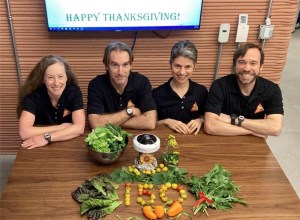
Host: Alright, that was Commander, Kelly Haston kicking us off. A few things about her experience that we can add a little bit of context to is so awesome to hear that they celebrated the Canadian Thanksgiving. Kelly has a footprint in both Canada and the United States. And of course, the other crew members spend much of their lives in the United States. So this is a nice opportunity for them. Any time there’s an international holiday added to the mix. And for a crew that is together for a year, it sounds like they very much look forward to reasons to celebrate. They look forward to the birthdays together and this is just another holiday that they can add onto the mix. So it’s really nice to hear them getting a chance to celebrate today together.
Of course, we kicked off in the intro that we’re going to have a special guest Gioia Massa here later in the episode to talk about some of the crops. We will note that of course, when these audio logs were recorded, they were recorded earlier in October. We got a chance to sit down with Gioia Massa. So when we talk to Gioia a little bit later, we’ll be hearing more about the process of what’s going on and the fact that they are there in the CHAPEA habitat and right now at the time of this recording. But at the time, they were still looking forward to the crops. So when we talk to Gioia, that will be a nice preview for next month when we actually get to hear from the crew on that experience getting to harvest and eat some of the crops that are part of their journey. Okay, next is CHAPEA Mission Flight Engineer, Ross Brockwell.
Ross Brockwell: Hello, this is Ross Brockwell. I’m the flight engineer for CHAPEA Mission 1, I’m checking in with Houston We Have a Podcast. Mission is still going great. We’re approaching the one-third point, still having fun, still learning, still have some challenges to tackle and some things to look forward to. So it’s going really well. Hoping, expecting to be able to say that for the rest of the mission. Say something similar in the upcoming months. Some of the highlights this last month, one thing for me that was really cool was we had a mission with the drone and the rover. So we get to remotely operate, pilot, these robotic vehicles to collect samples and to do, you know, aerial surveys. It’s really fun.
And the latest on the plant growth. We actually haven’t had our first harvest yet, but it’s coming up soon, obviously, we’re all really looking forward to that. For me, it’s not just because of the fresh food, which is going to be great, but just the systems like this to grow crops are really interesting to me. I’ve been looking forward to this. I’m really hoping to learn a lot from the experience.
“What if anything, has been more challenging about living and working on Mars than I expected?” You know, it’s interesting there are a lot of facets to this study and to maintaining Mars realism. So there are a lot of things to remember. A lot of things on the list. And they show up in different ways. They’re kind of scattered around different systems, different places. So I’ve kind of had to develop a method to keep all that stuff organized, so make sure I don’t forget or overlook anything. It’s been an interesting challenge and people that know me would probably laugh knowing that, you know, I have a tendency to do something similar in, in my day-to-day life on Earth. So that’s kind of funny that I’ve had to come up with a specific system that works for the complexities of life on Mars. But it’s been interesting, a lot of new things we learned at the start of the mission, of course, had to wrap our heads around. And a lot of challenges to meet. So some of them are expected, some are not. So it’s been kind of interesting to get better at them and work out systems individually and as a crew to manage them. No doubt there’ll be more of that in the coming months.
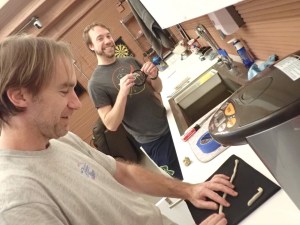
Ross Brockwell: Special crew bonding activities, I think we’ve mentioned this before, but we’ve done pretty well, you know, getting a library of different movies and shows here. So, you know, we’ve had a few that are become regular for us. So it’s been fun, something to look forward to and something we get to review together. And a lot of them have led to some pretty funny ongoing jokes. Some of them are Mars-relevant themselves. So that’s been a big part of our way to relax and our way to bond.
In the next month, we will have another series of EVAs, another set of peak performance testing in a few weeks, biological sampling. And of course, we’re really looking forward to the first crop harvest and also Thanksgiving’s going to happen. So it’s going to be a neat event, big milestone for us this coming month that we’re all looking forward to. So thanks a lot and we’ll see you next month.
Host: Again, that was Ross Brockwell the flight engineer of CHAPEA. We actually got a little bit of a taste perhaps, we’ll see. He mentioned some of his work with systems. Of course, Ross Brockwell with his civil engineering background fit into that role of the flight engineer. We could rightly assume that as in their respective roles with Ross being the flight engineer, Nathan being a medical officer with Anca being a science officer, perhaps they have some distinct responsibilities that pertain to those roles throughout their year-long stay. Good to know that in their crew bonding experience, a lot of the things that they’re watching do have a space element to it. I can only imagine the inside jokes relevant to Mars that this awesome crew came up with. Now we heard from Kelly Haston on the crew celebrating the Canadian Thanksgiving. Ross mentioned they’re looking forward to Thanksgiving in November. We can expect to hear about their experience during that holiday for Audio Log #6 because they’ll be recording Audio Log #5 earlier in November. Okay. Before we get to the last two crew members, we’re going to first speak with Gioia Massa about the crop production of CHAPEA.
Gioia Massa, thank you so much for coming on Houston We Have a Podcast. Glad to have you.
Gioia Massa: I’m delighted to be here.
Host: This is very timely to have you here. Last time we talked with you was for some of your work on the International Space Station. And we had to do it remote at the time. You’re based at the Kennedy Space Center, but we just had this opportunity to sync up in person. You’re here in Houston to check on the CHAPEA crew.
Gioia Massa: Yeah, yeah. We are here for the crops this week. And we’re really excited to be a part of CHAPEA.
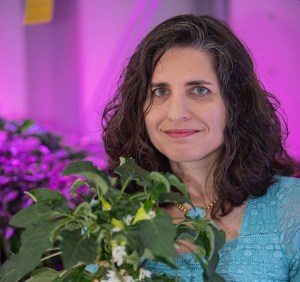
Host: So this is your last day here, right? You’re flying out later this morning. How did everything go? How’s everything looking?
Gioia Massa: Everything went fantastic. We have gorgeous plants, and the crew are now enjoying them. So we’re really delighted.
Host: Well, this has been a long time coming, we wanted to have you on for a while because the crew just keeps talking about it in all the audio logs. We’ve got crops coming! They’re so excited for it. So just can’t wait to dive in. I want to get to the audience to know a little bit more about you first, Gioia. I wonder, we’re going to lead to how you got to be a part of this experiment, but I wonder where your passion started, maybe earlier in your life for doing what you do now. Is space crop production? What sparked early in your life to get you where you are today?
Gioia Massa: Yeah, it was a long time ago actually. I was 12 years old, and I had an agriculture teacher. I was taking an Ag class and my teacher was invited to the Kennedy Space Center. He learned about the research growing plants for space at KSC. And, you know, he brought back a ton of information. This was in the ‘80s, so he had his handheld video recorder with him the whole time. And I just watched all those videos and I was just fascinated. I’d always liked plants, liked science a lot, but I knew then that’s what I wanted to do. So a few decades later, I finally got to be a NASA intern, which was a wonderful experience. I worked as part of a NASA center at a university doing, you know, what’s called bio-regenerative life support. So essentially, you know, growing plants and using biology to help support a space crew, looking at ways to produce food, but also recycle wastewater and revitalize the air, you know, all of which plants can have some part of and microorganisms and other types of biology.
Host: Wow. I think it’s fascinating cause not everybody has such a specific goal in mind. I mean, that is space crops. This is something very specific, not just the idea of space or not just plants, and then you work your way to space. Seems like you were passionate about this from such a young age and now you’re living it. This is fantastic.
Gioia Massa: It’s a dream come true. So it’s really great. I also did some space biology work, looking more at fundamental, you know, plant responses to gravity. But I really love the crops and the food production, appeals to me a lot more.
Host: Yeah. And that’s some of your work that you’ve done on the International Space Station as well. This is where we got the chance to talk with you earlier. And in this podcast, one of the earlier episodes was about some of your work on the International Space Station. I think a lot from there translates to what we’re seeing a lot from what we learned, maybe on the International Space Station. Can you talk briefly about some of your work aboard the ISS?
Gioia Massa: So I’ve been working on the ISS, both with my own research and then also helping support other researchers who are doing experiments. Our research that we’ve primarily focused on from Kennedy has been looking at crop production in the Veggie hardware, which is the sort of astronaut garden on the space station. We’ve also worked with the Advanced Plant Habitat, and we’ll be having an experiment going on in that soon. That’s more of a plant physiology research chamber, but we’re going to be using it for testing some crop production and asking different questions and helping to answer those questions about how water content and moisture for the plants impacts their growth and also their microbiology, their microbiome.
With Veggie, we’ve done work testing different crops, looking at different light recipes, you know, how to grow the crops under different red to blue light treatments to see if we can impact their yield, but also their nutritional content, their food safety. And we’re also starting to do a lot of human research looking at how plants make the astronauts feel, and how they may taste differently in space as well. So all the different aspects of growing plants. You know, there are so many places that they touch on our lives, whether it’s behavioral health or food or just, you know the air we breathe. You know, we’re trying to understand how all of those may impact plant growth moving forward.
Host: Yeah. Not just plant growth, I think it sounds like a lot of pieces of the experiments that you’re touching is really trying to better understand crop production in space and for long-duration travel for human space flight missions. It’s really to support something like where CHAPEA is the human research study, but we can see something like this, humans on Mars for an extended period of time and crop production being a part of that story. So a lot of your work really definitely is translating very nicely to, I think, what you have put into CHAPEA.
Gioia Massa: Exactly. And, you know, analogs like CHAPEA are really valuable for answering certain questions that we can’t answer on the space station. You know, we don’t have enough room, or we may not have enough crew time, or we may not have, you know, the resources available to easily do the experiments or do the testing. And so we actually sent one of our scientists to Antarctica a couple of years ago to work at the EDEN ISS facility, which was at the German Neumayer Station. It’s a German Space Agency project. And she was down there growing crops over winter in Antarctica, collected a ton of data, which we’re still analyzing a ton of plant samples and human data as well. Now we’re doing CHAPEA, so we’re going to learn, you know, how a crew on Mars interacts with the plants, how the plants can be an important part of their diet, how the plants may make them feel. And all of these are questions that we just can’t answer without these types of studies.
Host: This has been a recurring theme for a lot of the guests that we’ve had, going through these audio checks is just CHAPEA creates that much rounder perspective that it’s hard to find in other places. And so, I wonder where you got pulled and you got pulled for adding a crop production element to CHAPEA. How did this start for you?
Gioia Massa: So, Grace Douglas, the CHAPEA PI (principal investigator) came to me when she was planning this study and said, you know, “We really want crops to be a part of this.” We’d worked together on other experiments. She’s a co-investigator on one of my space station projects. And she’s also been just really encouraging and enthusiastic and kind of closely monitoring all of our work in space crop production. So when she broached the subject of trying to do a study like this, we were very excited because it really would be a way to collect the data that we need to understand whether crops are going to be a part of a future Mars mission and how long that mission, you know, should be to kind of enable crops, how many crops we might want to have and then the roles that those might play.
Host: I see. Okay. So you’re touching on this already, what exactly is it about CHAPEA that rounds out that perspective for you on crop production? And we can compare it to ISS, we could compare it to other analogs like the Antarctic mission. But you mentioned a couple of things, maybe the diversity of plants, maybe the mental health aspects of the astronauts. What are you looking at as part of this test?
Gioia Massa: Well, CHAPEA is specifically, as the name suggests, a Health and Performance Exploration Analog, right? And so we need to understand the role that crops may play in future health and performance. For food systems on Mars, this could be important because there have been studies, Grace’s lab has led a lot of these, that have shown that some of the foods will degrade when they’re stored over long durations, which is not a problem on the space station. They get regular resupply of foods all along.
But for Mars, that could be a problem. But we also want to see if it helps with menu fatigue. And that’s a real concern for long-duration missions, because if you’re eating kind of a restricted menu, over time people may start to get tired of the food. You know, they may start to not eat as much and maybe they’ll lose weight or maybe they’ll be more selective in what they eat. And so they might choose foods that don’t give them all of the nutrients they need.
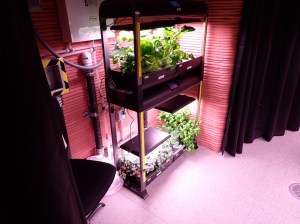
Gioia Massa: So one of the thoughts is that perhaps crops can help give a lot more variety to the diet, more options of things that they can create, put together new food ideas perhaps. I heard the crew talking, you know, about how they like combining the different foods and making new things out of them. So crops are going to really augment that. It gives you the creativity that, you know, we have here on Earth, because we can just go to the grocery store when we see a neat food we want to try or imagine a new recipe that we want to create. But in space, they don’t have that option. They have, you know, a restricted set of foods, a limited set, and even if it’s pretty broad, they don’t have all the things that we can pull from here.
So adding crops that give the variety where they can maybe add herbs to different packaged foods to change the flavor or make salads or make things like, the astronauts, we’ve seen them make lettuce wraps on station, or they’ve taken some of our crops and they’ve wilted them with garlic and soy sauce in their food warmer and made side dishes, you know, and so it just gives that added bit of creativity. And then, you know, plants are also really important, I feel. And that’s what we want to study from a behavioral health. When you are away from Earth and you’re living in working in an isolated, confined, maybe stressful environment, having something green and growing to remind you of Earth, I think can be super beneficial. And gardening is relaxing for a lot of people. It can be stressful for some people if you have a brown thumb, but for many of us, you know, it’s a relaxing thing to tend plants to watch them grow. So I think for all those reasons, plants are going to be really important. And we can start to measure that.
Host: That’s fascinating. So yeah, the health and performance aspects are very interesting. I know, you know, through these audio logs, we’ve had crew members talking about missing crunchy things and just those like little texture things can be a huge addition and it’ll be very interesting.
Gioia Massa: Yeah, we’ll have crispy and juicy and tart and tangy and, you know, some different flavors and textures that they will perhaps have been missing. We don’t have potato chips, which I know they’ve all kind of mentioned, and popcorn and things like that. Sadly, we’re not growing any of those right now, but maybe someday.
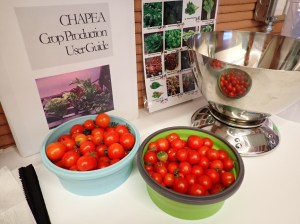
Host: Couldn’t fit the potato chip plant on there. Well, I guess potatoes Yeah. The famous “Martian,” the Mark Watney and all that. Yeah.
Gioia Massa: Yeah. Yeah. We’re focusing right now on the pick-and-eat crops that you can pick and eat directly like the, you know, salad crops, leafy crops, tomatoes, peppers, herbs. But, but in the future, staple crops like potatoes are definitely for consideration. And NASA’s actually done a lot of work on potatoes. One of my colleagues is like a world expert in potatoes, but when you take potatoes, sweet potatoes, you need some way to cook them, you know, you need cooking equipment. And right now we don’t have anything like that on the space station. We just have a food warmer. Maybe we will someday on a permanent planetary mission like habitat or settlement. But, you know, that’s a lot of mass to start to bring. And things like wheat and soybeans are also great candidate crops. We can certainly grow them, and they have been tested in space, but you’ll need processing equipment like milling machines and threshing machines and, you know, bread machines and pasta makers and tofu presses and things like that. So it’ll be a little farther down the road.
Host: Thus the pick and eat plants that you suggested. These are ones that you only need the facilities of the space crop production, and then you just pick it off and you can add it to whatever meal.
Gioia Massa: Yes. We also are sanitizing the produce and, you know, we have the astronauts do this with sanitizing wipes. For the CHAPEA crew, they have it a little bit easier. They have a salad spinner, and they have a sanitizing solution that they can use. But it helps to knock down any microorganisms as well as get off any debris that might be stuck to the leaves. And, you know, we want to make sure that no one gets sick. So safety is our first priority for this in every mission that we do. And, you know, we really want to ensure that. But we want to make sure things are clean, but also fresh and taste good.
Host: Okay. Yeah. So there are a lot of different elements in here that I can see that’s part of this test. wonder though, you mentioned, it seems like the focus of this is mostly from the health and performance aspect. I wonder if there’s anything that you are looking at in terms of space crop production, in terms of the soil contents or the light that you’re using, maybe that’s been refined over some of the other studies on ISS and through the other analogs. I wonder if there’s any element to that and then or if keeping a focused perspective on this particular crop test.
Gioia Massa: So for CHAPEA, we’re actually using commercial hardware to grow the crops, and it’s hydroponic, so it uses a nutrient solution. It works great on the ground. It’s not something we could fly on space station because it’s based on gravity. But, you know, Mars will have some gravity. So it’s a system that could potentially work on Mars. It has standard lighting, though the CHAPEA crew can raise and lower the lights to kind of keep up with the plant growth. So we want the lights a set height above the plants to give them the right amount of light. They can also change the day-night cycle, but they can’t change the color of the lights like we can in our space station hardware. So we’re not using soil.
We do have them doing some science tests as well, some plant science tests. This is to simulate what you might do on Mars if you were to take seeds with you to look at the radiation exposure on the trip to Mars, and potentially to look at things like what happens when you sprinkle a little bit of Mars, regolith, a little bit of Mars dirt in those seeds, and will they still grow. Now Mars regolith, you know, has toxins and things like that, so for growing crops in the future, like the movie “The Martian” showed, there needs to be quite a lot that wasn’t shown in the movie or in the book about remediating that and removing some of these toxins like perchlorates on the surface. But the CHAPEA crew is going to be testing some seed germination as well. This is independent from when the crops are grown. They’ve already started some of those tests and they’ll look at storage of seeds over time and adding some of the little Mars regolith in their glove box and seeing if the seeds do grow with them. Simulated Mars regolith.
Host: So it’s a little bit separate though from the crop production?
Gioia Massa: It’s separate from crop production. Yeah. We’re only looking at germination testing. We do have them saving some of the seeds from some of the crops that they’re growing, the tomatoes and peppers. And they will also store those and test them so that they can see if seed saving can work well in a Mars mission. So that it’s going to be, I think, pretty fun for them as well.
Host: Very good.
Gioia Massa: The crew seems really excited about growing crops. We’re just delighted to be working with these folks who are so enthusiastic. I’ve been listening to them on all your podcasts, I’m just loving hearing of their experiences, but I know they’ve mentioned crop several times, and I do a happy dance every time I hear that. And then, you know, just to be working with such an incredible team of scientists on CHAPEA, you know, we are plant scientists at Kennedy Space Center, so we don’t have the human nutrition and biochemistry and behavioral health and all of those team members. So we have to work with a team like this to be able to collect those data and to really understand the impacts of different food systems on crew health and performance in so many dimensions that we otherwise would never be able to get. You know, we can tell you how healthy the plants are, but we need to understand how healthy the crew is with plants, and that’s just super exciting
Host: So, this is fascinating Gioia, and I wonder what you’re looking forward to in the future. Now, CHAPEA, you have CHAPEA, right? But, you know, maybe for future missions like this, can we see more of a rinse and repeat to get consistent very good data with more subjects? And adding to that question about what’s coming ahead is really the value of that repeated study and with all these integrated players as you’re mentioning. That is maybe more unique from other studies we’ve done.
Gioia Massa: Exactly. I mean, this is very unique. There have not been any ways to collect these types of data before, and because it’s such an integrated team and it’s a wonderful team. I have to say, working with the CHAPEA team has just been one of the highlights of my career because everyone has been so passionate about it. I mean, Grace has been just tremendous leader and force for pulling us all together, and everyone’s just really excited about this. The data are going to be totally unique, but, you know, as with any science, we have to have a large enough subject number to really understand things. But everyone’s different. And some people I think, will really find value of having fresh food. Other people may not, or they may not enjoy caring for the plants as much. And so getting a large enough subject pool, to really understand what role people will have for plants in future missions and or roles they may have. We’ll be doing three CHAPEA missions and we’ll be able to get really great statistical data.
Host: That’ll be a good sample set. That’ll be a good understanding. And yeah, more science. What’s wrong with that? Love the science and the integrated science too, right? We’re doing these highlights of all these different aspects and it’s really coming together just how round this study is.
Gioia Massa: So CHAPEA is going to be a gold mine of information, I think.
Host: Gold mine. Very, very exciting. Gioia Massa, thank you so much for coming on Houston We Have a Podcast talking about this thing that we’ve been anticipating for so long, spacecraft production. Such a wonderful opportunity to get to have you here in our studio today. Thank you so much.
Gioia Massa: Thank you for inviting me.
Host: Great conversation with Gioia Massa. Okay, two more audio logs to go. Next is Medical Officer, Nathan Jones.
Nathan Jones: Hello, my name’s Nate Jones. I’m the medical officer for CHAPEA Mission 1. So far things have been going very well for our crew. We haven’t had any major issues that I can think of as far as this past month goes. The big notable event was that we went past our hundredth day in the habitat, and so we had a little celebration for that. We also received a small gift from NASA that was prepositioned for us on Mars. As far as other notable things in my life, I had my 15th wedding anniversary this past month. I did what I could to make the day special for my wife, despite the distance. Part of it didn’t really work out though the way I planned for it to specifically. I had a gift that I had positioned on Earth and for some reason, you know, I wasn’t able to get to her. In the end, I ended up improvising. I felt like it all turned out pretty well. I had planned to get a bit creative though, and so I drew a portrait of my wife. And since the other gift didn’t work out, I ended up playing a song on guitar that I had written, and I sang it to her on a recording. I’m not sure that I’m ready to go on “The Voice,” but she did assure me that she thought I did well. Anyway, my wife had sent me a card and a picture that I really appreciate. She wrote me a nice message in the card, and so I thought it was a good day in the end.
Another interesting thing is that Johnson Space Center had an Open House recently, and so the Public Affairs team actually took cutouts of astronauts in spacesuits with our faces visible inside them. And we went on a tour of Johnson Space Center and got to meet many people there. And they sent us pictures afterwards. So we all thought that was fun.
We’re excited to get our crops, but unfortunately, we haven’t gotten any of them yet. It’s still one of the things that we’re looking forward to. We’re anticipating that it will be in the next couple of weeks. And we feel like they’re close enough. We can almost taste them, if you will. So fingers crossed that that all goes well. We have had some limited seeds that we have planted in some Mars stimulants to see how well they would grow and then compare them to a control and then document them. But we don’t usually let them grow very long. And so they don’t ever grow to the point of allowing us to get any fruit from them.
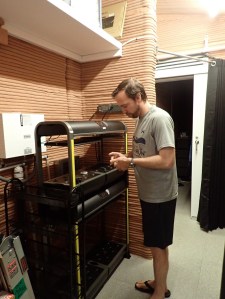
Nathan Jones: Some of the most interesting parts of the mission so far for me have been regarding some of the IT challenges now. I think we all knew that there were going to be some challenges with IT, especially considering the time delays. We went from 15 minutes, we’re going up to 22 minutes, and then back down to, I think it’s 13 minutes during the course of the mission. So being the first of even missions like this, we, I think we’ve experienced some IT issues. And so those have been interesting to work around, especially with a 20-minute delay and the resources we have available to us here. You know, for instance, one thing that happened to us is our microscope that we use for doing some science kind of stopped working on us. It was a technical issue on the computer’s end because it uses a camera inside the microscope to transmit the video or images to the computer. And for some reason, it developed a driver issue. Whenever you realize that we have such a limited bandwidth to connect to Earth to get data back and that a Windows update might be many gigabytes, you’ve got to imagine it takes quite a while to get a large enough file in order to update Windows and what is essentially dial-up internet speeds. And on top of that, with a 20-minute delay, obviously we did the thing that everyone gets told you by it, and that’s where we restarted it. But when that didn’t fix the issue, you know, we had to keep on working with mission control to figure out how to solve the problem.
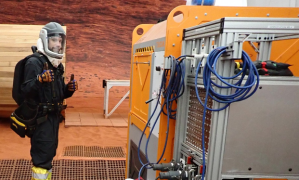
As far as crew bonding activities go, we have a mini basketball hoop that we set up at one point and we enjoyed playing games like a horse or similar. We jokingly said that we were the best basketball team on Mars. But that’s because we didn’t have any competition. I don’t think any of us are too amazing. I should probably just speak for myself though. But it was fun to play. We also have had a long-running game of Texas Hold’em. It just won’t seem to end. We can’t seem to get to any winners of the game, but we’ve enjoyed playing it. In addition to that, we have had two birthdays in the past month, and those were fun. We got some additional birthday-type foods associated with that. And we even have a little LED candle that we brought that we “blow out.” We also celebrated Canadian Thanksgiving since our commander is Canadian. And we have some other plans for upcoming holidays in case there are any spoilers there that we decide to share later, probably let’s discussed those in the future, though. In the next month, we plan to celebrate Halloween. We have some fun ideas to celebrate in amusing ways. Today actually, we plan to decorate for Halloween and kind of set up the habitat so we can sort of celebrate it.
Nathan Jones: Other things coming. We are excited about the crops that I mentioned previously coming here in the next couple weeks. And then in the next couple weeks, we also will cross our one third of the mission milestone. And so that will be something to celebrate every time we can kind of cross a milestone and, and I remind ourselves that we’re moving along with a mission. It’s always good for morale. That’s all I have for now. Thank you so much for your time and interest in our mission.
Host: Alright, that was Medical Officer Nathan Jones reflecting on his experience this month. Lots happening on Dune Alpha. He mentioned a couple of things. One of them was the JSC Open House. This was an event we had on October 14 and opened up the gates of the Johnson Space Center to the public and had a number of different events across the center. Nathan mentioned the changes in delay and the fluctuations of the delay that are needed to communicate between Mars and Earth. This can be expected on a mission of this duration for a crew going to Mars and is even the case for the many rovers and landers that we have on Mars and how we communicate with some of the hardware there.
We can expect these to fluctuate throughout the year as the position of Mars and Earth change, relative to one another. Finally got a taste of that Mars inside jokes. I know Ross was alluding to it during his audio log, but the best basketball team on Mars, really hard to beat that one. And of course, another holiday. Of course. How can we forget Halloween? I hope they got to celebrate that one. I’m interested to see some of the decorations that they had hanging on in the Mars habitat. Okay, last but not least, here’s Science Officer Anca Selariu.
Anca Selariu: Hello Earthlings, and welcome to CHAPEA Mission 1. I’m Anca Selariu, the science officer, and today I’m going to tell you a little bit about what happened last month and what is likely to happen next month. Although sometimes Mars offers plenty of surprises, I am especially excited that in the beginning of the month, we found out that the end of the month will bring us crops. This is extremely exciting for me because I plan to name some of the plants by the names of the minions. October also offered planned and unplanned events, very exciting opportunities for science and discovering. We’ve also retrieved a new core sample and analyzed it and found very exciting stuff, as well as having to deal with some interesting habitat repairs, including fixing a sink, which revealed the tinkering spirit of the crew. And that’s always fun to watch this month.
We also celebrated Canadian Thanksgiving and it’s really exciting to get to celebrate and share a meal with people who you admire and respect. And it’s always fun to be around them. We do have plenty of opportunities for team activities and interestingly, we have some of them scheduled, but most of them are unscheduled, and we’re just always coalescing in the recreation room and end up doing some something fun together nearly every day. These include anything from playing, from watching videos that are prerecorded, just talking, talking about books, talking about our lives, talking about experiences, what we want to do, what we dream of. It’s really exciting to hear everyone’s thoughts and ideas and, it’s so surprising that every single week is a new opportunity to learn something unique about people that you shared this habitat with. It’s always wonderful to discover their additional talents because I tell you, all of them have lots of talents, science-wise, I’m not able to share too many details of everything that we’re doing. Well, that is it for me. I hope you Earthlings are doing well and take care of Earth and each other. Thank you. Bye.
[Music]
Host: Alright, that’s it for our audio logs. And that was Science Officer, Anca Selariu. Always great to hear from Anca and her experience. She mentioned a couple of things. Of course, you know, we talk about a lot of the science that they’re doing, the EVAs, but we can expect this for literally any crew traveling in space is some maintenance activities. Happens all the time on board the International Space Station. It will of course be part of their daily, weekly, monthly routines, maintaining their living space in wherever they are, in this case, Dune Alpha, the habitat for the CHAPEA mission. Gioia mentioned some germination experiments and we heard it from here, from Anca that the experiment seems to be going well. Of course, there are several different experiments, but her mentioning the germination was fantastic. And of course, we heard from Gioia about the crop production as well. It was great to get confirmation from both Gioia and Anca, no potatoes on Mars quite yet.
So that’s it for Audio Log #4 from Dune Alpha. Thanks for sticking around and I hope you’re enjoying the cruise journey. This is the fourth audio log in our series. You can tune in once a month to check in on the crew. Check out nasa.gov for the latest on CHAPEA and a lot of the happenings across the agency, nasa.gov/podcasts to check out our podcast and listen to any of our episodes in no particular order. And while you’re there, you can also check out some of the other great shows we have across the agency on social media. We’re on the Johnson Space Center pages of Facebook, X, and Instagram and you can use #AskNASA on your favorite platform to submit an idea for the show, just make sure to mention it’s for us at Houston We Have a Podcast.
Recordings were sent from the CHAPEA crew through October. And we had the conversation with Gioia Massa on October 31, 2023. Thanks to Will Flato, Dane Turner, Abby Graf, Jaden Jennings, Dominique Crespo, and Anna Schneider. Thanks to Gioia Massa for taking the time to come on the show. And big thanks to Kelly Haston, Ross Brockwell, Nathan Jones, and Anca Selariu for sharing their experience for this audience on Houston We Have a Podcast. Give us a rating and feedback on whatever platform you’re listening to us on, and tell us what you think of our podcast. We’ll be back next week.


























